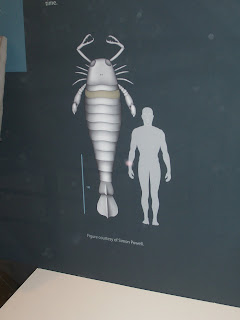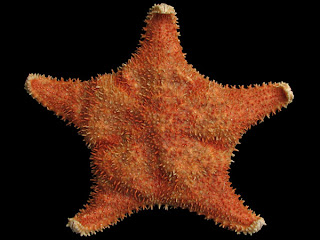 (Division of Invertebrate Paleontology, YPM # 220638, Courtesy of the Peabody Museum of Natural History, Yale University, New Haven CT, USA)
(Division of Invertebrate Paleontology, YPM # 220638, Courtesy of the Peabody Museum of Natural History, Yale University, New Haven CT, USA)And now the conclusion of my travel to Yale's world famous Peabody Museum in New Haven, CT where I was visiting the Department of Invertebrate Zoology and the adjacent Dept. of Invertebrate Paleontology!
I stayed at a local hotel which included waffles made with a waffle-making-machine which was part of their complimentary "continental breakfast" offerings!
 MMMmmmm...waffles!
MMMmmmm...waffles! This and a cup of coffee later..I'm off to the museum!
This and a cup of coffee later..I'm off to the museum!After a search through the collection and working on their newly collected specimens from deep-sea Seamount expeditions and other exotic locales, I proceeded to review the older parts of their collection, and many interesting historical items presented themselves!
This dried and brilliantly painted asteroid, Dermasterias imbricata
 Also came upon a very amazingly dissected Aristotle's "Lantern" in the collection.. Really hard to find one that is quite so well prepared...
Also came upon a very amazingly dissected Aristotle's "Lantern" in the collection.. Really hard to find one that is quite so well prepared... I was also able to delve more deeply into the historical artifacts and lore of the Yale Peabody Invertebrate collections!
I was also able to delve more deeply into the historical artifacts and lore of the Yale Peabody Invertebrate collections!Here, Collections Manager Eric Lazo-Wasem showcases a portrait of the noted Harvard biologist and naturalist, Louis Agassiz
 And one closer...
And one closer... I was also got a full dose of the history of famous American zoologist Addison Emery Verrill, whose full bio can be found here.
I was also got a full dose of the history of famous American zoologist Addison Emery Verrill, whose full bio can be found here.An incredible painting of Verrill can be found in the Invertebrate Zoology offices...

 Here is a photo of Verrill for comparison..
Here is a photo of Verrill for comparison.. What did A. E. Verrill do for us?
What did A. E. Verrill do for us?Well, in his day, (roughly the 1860s to the early 1900s) Verrill was one of the most prolific and pre-eminent invertebrate zoologists in the United States. He described over 1200 taxonomic names of various marine species, including corals and worms!! (although to be fair-not all of them remain valid, but still...) Approximately 290 of these names were starfish....
If you work on the Pacific Northwest coast, here are a couple of Verrill's starfish names that have remained "good species" in spite of taxonomic changes over the last 100 years or so...
Solaster dawsoni was described by Verrill in 1880!!
and the North Pacific coral and sea pen predator Hippasteria spinosa which was described by Verrill in 1909.
and there are many more...
Shifting Gears-A Visit to Invertebrate Paleontology!
So, during this visit, I also took some time to visit the equally world famous Invertebrate Paleontology department at the Peabody Museum to examine starfish fossils.. (which for various reasons I won't be showing you here...)
But here is an excellent shot of a nicely preserved Paleozoic crinoid, Seirocrinus subangulatus YPM specimen 210116. A species that some people think was pelagic...(click here)
 (Division of Invertebrate Paleontology, YPM # 210116, Courtesy of the Peabody Museum of Natural History, Yale University, New Haven CT, USA)
(Division of Invertebrate Paleontology, YPM # 210116, Courtesy of the Peabody Museum of Natural History, Yale University, New Haven CT, USA)The Yale/Peabody museum is home to the Lab of Dr. Derek Briggs, an expert on Cambrian invertebrate forms, especially those associated with the Cambrian Explosion.
As a result, there are some awesome models representing the living interpretations of various Paleozoic invertebrates that were in the Paleo department collections! Many of these were made by the masterful artist George S. Rennie III who produced models for many different departments in the Peabody Museum.
Here is a good-sized model of the Cambrian predator Anomolocaris nathorsti..Wiki on Anomalocaris is here. (Note that All images below are courtesy of the Division of Invertebrate Paleontology, Peabody Museum of Natural History, Yale University, New Haven, CT, specimen YPM 203911)
 View from the perspective of potential food!
View from the perspective of potential food! And a dorsal view...
And a dorsal view... Here is model of the Cambrian Priapulid worm, Ottoia prolifica (wiki article is here), which could get to up to 80 CENTIMETERS in length!! (All images below are courtesy of the Division of Invertebrate Paleontology, Peabody Museum of Natural History, Yale University, New Haven, CT.specimen YPM 203912)
Here is model of the Cambrian Priapulid worm, Ottoia prolifica (wiki article is here), which could get to up to 80 CENTIMETERS in length!! (All images below are courtesy of the Division of Invertebrate Paleontology, Peabody Museum of Natural History, Yale University, New Haven, CT.specimen YPM 203912)  So, with me there for scale, we see that this model was actually close to life sized!
So, with me there for scale, we see that this model was actually close to life sized!Another cool giant Paleozoic invertebrate-A huge stylonurid!! Based on an actual head-shield, making this model a reconstruction of a LIFE SIZED individual!! (All images below are courtesy of the Division of Invertebrate Paleontology, Peabody Museum of Natural History, Yale University, New Haven, CT.specimen YPM 220638, )
 Stylonurids were related to eurypterids-Giant predatory "sea scorpions" that swam through the shallow seas on the Paleozoic.
Stylonurids were related to eurypterids-Giant predatory "sea scorpions" that swam through the shallow seas on the Paleozoic. Here is a schematic from one of the hallway displays showing how big some sea scorpions (not stylonurids but related to) got relative to humans..
Here is a schematic from one of the hallway displays showing how big some sea scorpions (not stylonurids but related to) got relative to humans.. Yet, another reminder of how, if you find yourself in the Paleozoic, you should NEVER go into the water!
Yet, another reminder of how, if you find yourself in the Paleozoic, you should NEVER go into the water!And here is a model of the Paleozoic worm Plumulites which is thought to have been ancestral to modern polychaetes. (gratefully, this was not life sized! )

 And here we have some hallway displays of more giant Paleozoic arthropods, such as this eurypterid!
And here we have some hallway displays of more giant Paleozoic arthropods, such as this eurypterid! A close up of this mean beast!
A close up of this mean beast! and finally a Trilobite display!
and finally a Trilobite display! I had a very productive trip to Yale and was enthusiastically recieved/hosted by Yale's friendly and gracious staff! In Invertebrate Zoology: Collection Manager Eric Lazo Wasem and museum assistants, Lourdes Rojas and Daniel Drew and in Invertebrate Paleontology: Collection Manager Susan Butts and museum assistant Jessicz Bazeley!
I had a very productive trip to Yale and was enthusiastically recieved/hosted by Yale's friendly and gracious staff! In Invertebrate Zoology: Collection Manager Eric Lazo Wasem and museum assistants, Lourdes Rojas and Daniel Drew and in Invertebrate Paleontology: Collection Manager Susan Butts and museum assistant Jessicz Bazeley!



No comments:
Post a Comment